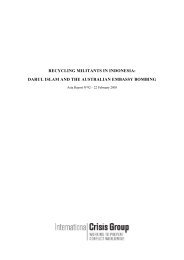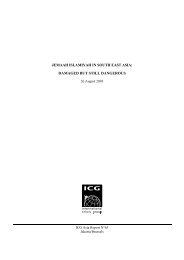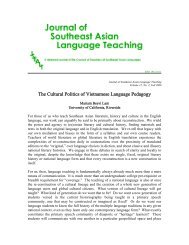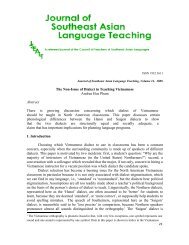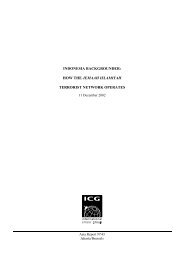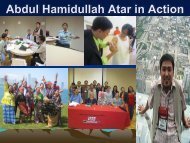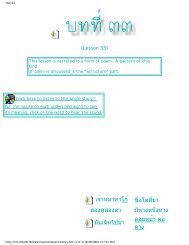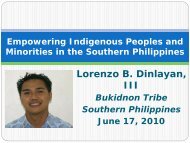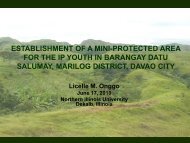Introduction - SEAsite - Northern Illinois University
Introduction - SEAsite - Northern Illinois University
Introduction - SEAsite - Northern Illinois University
Create successful ePaper yourself
Turn your PDF publications into a flip-book with our unique Google optimized e-Paper software.
Prentation Abstracts<br />
Western culture in order to keep their traditional performance and Molam’s spirit,<br />
for example play the local musical instrument “Kaen” and “Pin” along with their<br />
show.<br />
3. The trend of Culture Industry allows Molammore spaces to show more of<br />
its identities. The spaces are largely in mass communication media such as press,<br />
magazine, TV, Radio, tape cassette, VCD, even cyber space where there are websites<br />
setup by fans of famous Molam artists.<br />
4. However, The Culture Industry also affects local performing arts to be<br />
distorted from its original style due to the enterprises’ urgent need to produce<br />
plenty of Molam for their market. This makes the young generation of Molam<br />
artists ignore the roots and spirit of the performance.<br />
5. When Molam becomes cultural commodities due to mass production, its<br />
values and its duration as a classic art form seem to be reduced continually. The<br />
tasks of the artists are to produce the performing art for the sake of business transaction<br />
instead of for the aesthetic values of the art as the Molam artist in the past<br />
do.<br />
As mentioned above, we witness the phenomenon of cultural collision between<br />
local performing arts and Culture Industry which brings both advantages<br />
and disadvantages to the performance art of Molam.<br />
Remark: Molam’s meanings are:<br />
1. The performer mastering in dancing and singing in a type of northeastern or<br />
Isan Lao folk performance.<br />
2. The form of one of the most popular local performing arts in the Northeast of<br />
Thailand which carries the unique characteristics of singing and dancing in the<br />
style of Northeastern folk performance.<br />
Seree Weroha, Ph.D.<br />
K-16 Lao Language Curriculum for Wisconsin<br />
Wisconsin Department of Public Instruction, Wisconsin<br />
Since 2001, the DPI has provided financial support to groups and individuals<br />
to work on Lao curriculum based on ACTFL standards and DPI guidelines on<br />
world languages. Lao language standards, curriculum, and assessment are needed<br />
for K-16 Lao language teaching and learning in Wisconsin. The goal is to design<br />
the Lao heritage/world language curriculum and instruction that meet the<br />
requirements of foreign/world language in K-12 setting and allow students to pursue<br />
higher levels of Lao language proficiency and literacy skills in postsecondary<br />
institutions.<br />
Joyce C. White<br />
Middle Mekong Archaeological Project Phase I: The Luang<br />
Prabang Survey<br />
<strong>University</strong> of Pennsylvania Museum, Pennsylvania<br />
The paper will report on the first phase of the Middle Mekong Archaeological<br />
Project (MMAP), a reconnaissance survey of three left bank tributaries of the<br />
Mekong River in Luang Prabang province, Laos scheduled to occur in March and<br />
April 2005. The main objective of this initial survey is to find sites likely dating to<br />
the middle Holocene, roughly 6000-2000 BC calibrated, in order to begin acquiring<br />
data to test alternative models for the appearance of agriculture in mainland<br />
Southeast Asia. Models postulating migration mechanisms for the appearance of<br />
agriculture in this region suggest the Mekong as one highway for southward-migrating<br />
rice cultivators originating in southern China. One migration model favors<br />
the late 3rd millennium BC for this expansion based primarily on dates associated<br />
with a widespread ceramic decorative syntax (Higham 2001:8, 2002:110).<br />
Another model based on linguistics favors the 6th millennium BC for expansion<br />
of rice cultivators down the Mekong from Yunnan (Blust 1996:132). However,<br />
northern Vietnamese data show that an autochthonous transition from hunting and<br />
gathering to use of domesticated foodstuffs during the middle Holocene cannot<br />
be ruled out (Bui Vinh 1997). Existing data from the middle Holocene in mainland<br />
Southeast Asia are currently too poor in quantity and quality to scientifically<br />
evaluate these alternative scenarios.<br />
Determination of the timing and nature of the development of early agriculture<br />
in Southeast Asia has implications not only for the culture history of one<br />
region, but also for the validity of the proposal that modern day global distributions<br />
of languages and populations represent expansions from a few well-defined<br />
regions where agriculture is proposed to have originated (Diamond and Bellwood<br />
2003). In this view, Southeast Asian languages, populations, and agriculture derived<br />
from the Yangtze basin where the earliest domesticated rice has been found.<br />
However, assumptions of this model for demography, plant genetics, and human<br />
biology may not hold for mainland Southeast Asia. Knowing if the subsistence regime<br />
underlying Southeast Asia’s long-term socioeconomic development emerged<br />
from an extraregional expansion driven by the development of rice cultivation,<br />
an autochthonous development of plant cultivation perhaps of multiple crops, or<br />
some combination of processes is important not just for evaluation of the universality<br />
of the Diamond/Bellwood proposal. Knowing if a rice-focused cropping<br />
system as opposed to a multi-species horticultural cropping system characterized<br />
Southeast Asia’s original agricultural regime is fundamental to understanding the<br />
region’s distinctive social, economic, political, and environmental trajectories<br />
(White 1988, 1995a, 1995b; White and Pigott 1996; White et al. 2003).<br />
The survey along three left bank tributaries to the Mekong in Luang Prabang<br />
province should identify sites that will allow evaluation of these alternative models<br />
for the emergence of plant cultivation in this core region. Luang Prabang is<br />
upstream from Ban Chiang cultural tradition sites in northern northeast Thailand<br />
where the earliest agricultural societies so far identified in the middle Mekong<br />
basin lie. Luang Prabang province is also on the western side of a divide whose<br />
eastern side witnessed subsistence changes during the middle Holocene that the<br />
Vietnamese claim involved exploitation of domesticated livestock. These two geographic<br />
factors indicate that there is no better location in all of Southeast Asia to<br />
seek evidence for changes in middle Holocene subsistence regimes than Luang<br />
Prabang province.<br />
Yang Sao Xiong<br />
State-Mandated Selective Testing, Classification, and Tracking<br />
of English Learners in California Public Schools<br />
Ph.D. Student, Department of Sociology, <strong>University</strong> of California, Los Angeles<br />
Southeast Asian refugees, especially their U.S.-born children, confront a multitude<br />
of socio-political obstacles to educational advancement and economic survival.<br />
Made invisible by policies which neglect the tremendous diversity of histories<br />
and experiences in contemporary American communities, Southeast Asian<br />
American children remain socially marginalized as the state erect multiple barriers<br />
to deny them equal access to quality education—their most important hope for<br />
prosperity in the United States. Through a critical examination of federal, state,<br />
and school district education policies and practices, this research identifies and<br />
explains how the processes of state-mandated selective testing, classification, and<br />
tracking of English Learners, including Southeast Asians, operate to systematically<br />
deprive these students of equal access to quality education in California’s<br />
public schools. Educational and social implications for Hmong-American students<br />
are also examined.<br />
Kou Yang, Ed.D.<br />
Hmong Americans: 30 Years In-Review<br />
Chair, Ethnic and Gender Studies Department, Associate Professor of Asian<br />
American Studies<br />
California State <strong>University</strong>, Stanislaus CA<br />
The experience of Hmong Americans during the last 30 years is very unique<br />
and fascinating. They came from very disadvantage background and must adapt<br />
to America, the most developed country in the world, from the very bottom up.<br />
The gap between the two cultures is very large, making it more difficulty for them<br />
to overcome their acculturation needs in a short period of time. Because of their<br />
unprepared background, their first 15 years in the United States are preoccupied<br />
with many difficulties, including cultural shock, unemployment, welfare reliance,<br />
poverty and other acculturation problems. The decade of 1992 to 1999 marks the<br />
second phase of their adaptation to life in the United States. This decade is the<br />
turning point for Hmong Americans as they began to run for office, develop business<br />
enterprises, and most importantly reduce the rate of welfare participation.<br />
Beginning from 2000, Hmong Americans have entered a new phase of adaptation<br />
to life in the United States. As they entered the 21st century, their population became<br />
more diverse, youthful, educated and assertive. Further, Hmong Americans<br />
have become more politically active, educationally competitive, and high-tech<br />
oriented. Furthermore, they have also entered many professions, including Art,<br />
Anthropology, Computer, Education, Engineering, Journalism, Law, Medicine,<br />
Military, Psychology, Science, Social Work, and Teaching. On the other extreme






